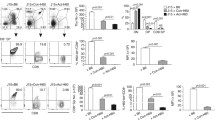Abstract
Recently we reported that antigen-primed T cells from (H-2 u × H-2 s)F1 and (H-2 u × H-2 q)F1 mice responded poorly in vitro to antigen in the context of antigen-presenting cells of the non-H-2 u parent. It was suggested that this effect might be due to unbalanced expression of parental antigens in the F1 hybrid with the result that the non-H-2u A antigens were greatly reduced or absent in these mice. If this were the case, non-H-2u Ia-A cells might be expected to stimulate a mixed lymphocyte reaction (MLR) when cultured with Fl responder cells. When tested, (SJL × PL)F1 responder cells reacted strongly to SJL stimulator cells. There was no significant reaction to PL stimulator cells. The use of major histocompatibility complex (MHC) congenic mice showed the stimulatory antigens to be associated with the MHC. The MLR could be blocked significantly by monoclonal A-specific antibody of the appropriate specificity. When a monoclonal antibody reactivewith a private epitope associated with As was used to probe for the presence of As on the surface of (SJL × PL)F1 spleen cells, no antigen could be detected, indicating loss or alteration of this antigen. These findings suggest that an alteration of the expression of the parental As molecule may be responsible for this phenomenon.
Similar content being viewed by others
Abbreviations
- APC:
-
antigen-presenting cells
- BSS:
-
balanced salt solution
- CTL:
-
cytotoxic T lymphocyte
- IL-2:
-
interleukin-2
- MHC:
-
major histocompatibility complex
- MLR:
-
mixed lymphocyte reaction
- T2 :
-
suppressor T lymphocyte
References
Accolla, R. S., Scarpellino, L., Carra, G., and Guardiola, J.: Transacting element(s) operating across species barriers positively regulate expression of major histocompatibility complex class II genes. J. Exp. Med. 152: 1117–1133, 1985
Conrad, P., Lerner, E., Murphy, D., Jones, P. P., and Janeway, C., Jr.: Differential expression of Ia glycoprotein complexes in F1 hybrid mice detected with alloreactive cloned T-cell lines. J. Immunol. 129: 2616–2620, 1982
Fathman, C. G. and Kimoto, T.: Studies utilizing marine T cell clones: Ir genes, Ia antigens and MLR stimulating determinants. Immunol. Rev. 54: 57–79, 1981
Fritz, R. B., Skeen, M. J., and Ziegler, H. K.: Influence of the H-2u haplotype on immune function in F1 hybrid mice. I. Antigen presentation. J. Immunol. 134: 3574–3579, 1985
Germain, R. N., Bentley, D., and Quill, H.: Influence of allelic polymorphism on the assembly and surface expression of class II MHC (Ia) molecules. Cell 43: 233–242, 1985
Gladstone, P. and Pious, D.: Identification of a trans-acting function regulating HLA-DR expression in a DR-negative B cell variant. Somatic Cell Genet. 6: 285–292, 1980
Howell, D. N. and Cresswell, P.: Expression of T-lymphoblast-encoded HLA-DR antigens on human T-B lymphoblast hybrids. Immunogenetics 17: 411–425, 1983
Howell, D. N., Hartzman, R. J., and Cresswell, P.: Expression of Tlymphoblast-encoded HLA-DR, MT, and SB antigens on human T-lymphoblast hybrids. Hum. Immunol. 8: 167–176, 1983
Matis, L., Jones, P., Murphy, D., Hedrick, S., Lerner, E., Janeway, C., Jr., McNicholas, J., and Schwartz, R.: Immune response gene function correlates with the expression of an la. antigen. II. A quantitative deficiency in Ae: Ea complex expression causes a corresponding defect in antigen presentation function. J. Exp. Med. 155: 508–523, 1982
McNicholas, J., Murphy, D., Matis, L., Schwartz, R., Lerner, E., Janeway, C., Jr., and Jones, P.: Immune response gene function correlates with the expression of an Ia antigen. I. Preferential association of certain Ae and Ea chains results in a quantitative deficiency in expression of Ae: Ea complex. J. Exp. Med. 155: 490–507, 1982
Norcross, M. A., Bentley, D. M., Margulies, D. H., and Germain, R. N.: Membrane la expression and antigen-presenting accessory cell function of L cells transfected with class II major histocompatibility complex genes. J. Exp. Med. 160: 1316–1337, 1984
Oi, V. T., Jones, P. P., Goding, J. W., Herzenberg, L. A., and Herzenberg, L. A.: Properties of monoclonal antibodies to mouse Ig allotypes, H-2 and la antigens. Curr. Top. Microbiol. Immunol. 81: 115–133, 1984
Ozato, K. and Sachs, D.: Monoclonal antibodies to mouse MHC antigens. III. Hybridoma antibodies reacting to antigens of the H-2b haplotype reveal genetic control of isotype expression. J. Immunol. 126: 317–321, 1981
Sandrin, M. S., Tobias, G. H., McKenzie, I. F. C., and Hämmerling, G. J.: Alterations in the expression of Ia antigens in F1 hybrid mice. Immunogenetics 14: 507–516, 1981
Schlauder, G. G., Bell, M. P., Beck, B. N., Nilson, A., and McKean, D. J.: The structure-function relationship of I-A molecules: A biochemical analysis of I-A polypeptides from mutant antigen presenting cells and evidence of preferential association of allelic forms. J. Immunol. 135: 1945–1954, 1985a
Schlauder, G., Bell, M., Paul, W., Glimcher, L., and McKean, D.: Biochemical characterization of I-Ak proteins from mutant antigen presenting B cell-B lymphoma hybridomas. Mol. Immunol. 25: 597–608, 1985b
Tewarson, S., Figueroa, F., and Klein, J.: Monoclonal antibodies specific for class I and class II molecules controlled by the mouse H-2 complex. Immunogenetics 16: 373–379, 1982
Uchida, T., Ju, S., Fay, A., Liu, Y., and Dorf, M.: Functional analysis of macrophage hybridomas. I. Production and initial characterization. J. Immunol. 134: 772–778, 1985
Wicker, L. S. and Hildemann, W. H.: Two distinct high immune response phenotypes are both controlled by H-2 genes mapping in K or I-A. Immunogenetics 12: 253–265, 1981
Zamvil, S., Nelson, P., Mitchell, D., Knobler, R., Fritz, R., and Steinman, L.: Encephalitogenic T cell clones specific for myelin basic protein. An unusual bias in antigen recognition. J. Exp. Med. 162: 2107–2124, 1985
Author information
Authors and Affiliations
Rights and permissions
About this article
Cite this article
Fritz, R.B., Skeen, M.J. Influence of the H-2 u haplotype on immune function in F1 hybrid mice. Immunogenetics 25, 161–166 (1987). https://doi.org/10.1007/BF00344029
Received:
Revised:
Issue Date:
DOI: https://doi.org/10.1007/BF00344029




